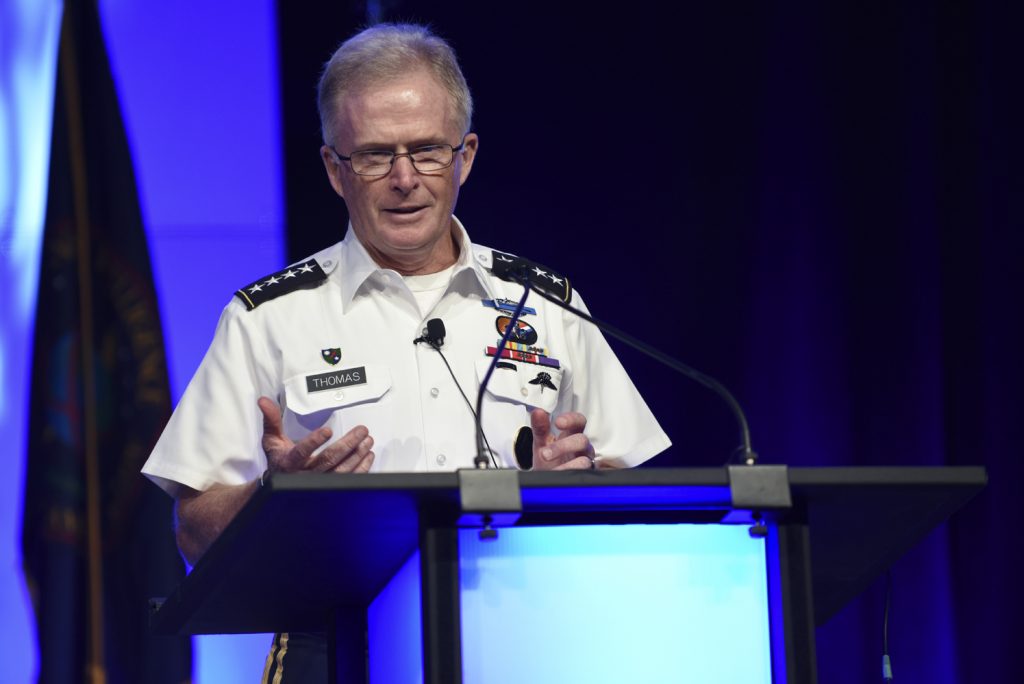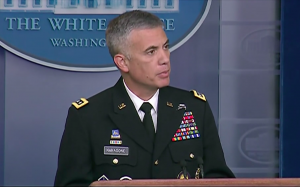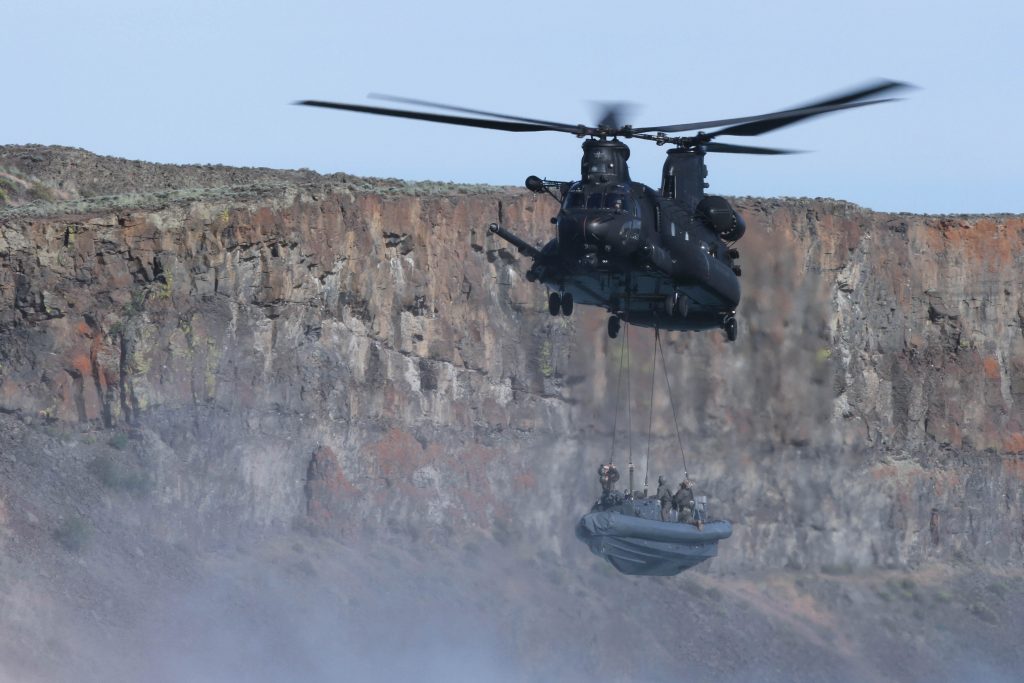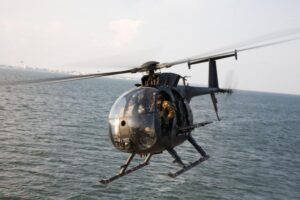Fix It Before It Breaks: SOCOM, JAIC Pioneer Predictive Maintenance AI
Posted on
The Pentagon’s new Joint Artificial Intelligence Center is about to deploy its first operational project, a joint venture with Special Operations Command to predict helicopter breakdowns before they happen. It’s the latest example of how SOCOM is applying artificial intelligence to real-world warfare, a cutting-edge role it previously played with the intelligence-gathering Project Maven.
Leading the charge since 2016: SOCOM’s outgoing commander, Gen. Raymond “Tony” Thomas, who one SOCOM source extolled as “truly the father of AI in SOF” (Special Operations Forces). But in his last Senate hearing before retirement, Thomas himself gave credit to the former CEO of Google for giving him a precision-guided kick in the pants.
Eric Schmidt heads the Defense Innovation Advisory Board meant to infuse outside commercial innovation into the stodgy Defense Department. An immensely experienced alumnus of Google, Alphabet, Sun and Xerox, Schmidt visited SOCOM’s Tampa headquarters three years ago, early in Thomas’s tour as commander.
“He felt compelled to give me [a] quick assessment,” Thomas recalled. “He said you’ve got tremendous people. You prototype pretty effectively, and you’re absolutely terrible — he had some more colorful words than that — for machine learning, applied artificial intelligence.”
“Truthfully, it gave me a spark three years ago and turned me into a zealot” for AI, Thomas said of Schmidt’s visit. “More importantly, it really has reoriented our command to embrace [artificial intelligence] and apply it.”
The working assumption at SOCOM today, Thomas said, is that AI “has relevance to everything we do until it’s proven otherwise. So we’re taking, not so small bites, but some pretty substantial bites, in embracing, applying artificial intelligence, and I’m excited about where we’re going in the future.”
Testifying alongside Thomas before the Senate Armed Services Committee was Gen. Paul Nakasone, who runs both Cyber Command and the National Security Agency, someone who’d better be an expert on AI.
“We have already seen the power at the National Security Agency of what artificial intelligence can do for our foreign intelligence mission, our cybersecurity missions,” Nakasone said when asked about AI. But rather than give specifics on his own highly classified projects, Nakasone passed the mike to Thomas with a compliment: “Special Operations Command really has led a lot of work in artificial intelligence.”
Maven & Maintenance
So what has Thomas done, exactly? Our SOCOM source gave us two examples, although there are probably more deep in the classified world: Project Maven and predictive maintenance.
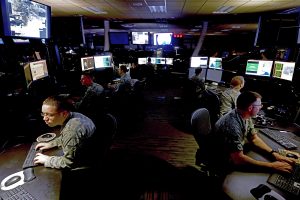 Project Maven was the brainchild of then-Deputy Defense Secretary Robert Work, who created an Algorithmic Warfare task force to apply AI to urgent military problems. (Ironically, one of the early private-sector partners was Google, which pulled out after protests from almost 4,000 employees). Maven uses AI to analyze intelligence on terrorist suspects, chiefly by combing through drone surveillance footage, and deduce their latest location for drone strikes or Special Operations raids.
Project Maven was the brainchild of then-Deputy Defense Secretary Robert Work, who created an Algorithmic Warfare task force to apply AI to urgent military problems. (Ironically, one of the early private-sector partners was Google, which pulled out after protests from almost 4,000 employees). Maven uses AI to analyze intelligence on terrorist suspects, chiefly by combing through drone surveillance footage, and deduce their latest location for drone strikes or Special Operations raids.
But AI is useless without data. Machine learning algorithms can’t learn without large amounts of pre-labeled, well-organized data to practice on. Thomas opened the information spigots at SOCOM for the Maven team.
“Much of Project Maven’s success is based on Gen. Thomas’ willingness to allow Maven both to use SOF data to train their algorithms and to deploy the technology into SOF’s forward-most locations,” as well as SOCOM facilities in the US, the source said.
The second project that our source could talk about was a collaboration between SOCOM’s long-established “Night Stalkers,” the 160th Special Operations Aviation Regiment (SOAR), and the Pentagon’s eight-month-old Joint Artificial Intelligence Center (JAIC). In support were leading AI academics at Carnegie Mellon University in Pennsylvania. (CMU is now home to the Army’s AI Task Force).
The objective was to do “predictive maintenance” on helicopter engines. Traditionally, you either do forensic maintenance, where you pull apart a broken system and try to figure out what went wrong this time, or preventive maintenance, where you do periodic check-ups based on historical averages for often this kind of engine, weapon, or whatever starts wearing down. But the emerging technique of predictive maintenance uses AI to analyze both historical data and detailed data from sensors installed on key components. The idea is to detect the early symptoms of an impending breakdown and prevent it, by doing the right maintenance on exactly the right component at exactly the right time. That way you don’t waste effort on unnecessary preventive maintenance or letting the engine break and then trying to fix it.
The 160th SOAR will be the “first DOD element to deploy AI” in concert with the Joint AI Center, our source said: “We are nearing completion of the development of the first algorithm with the intent of predicting a maintenance requirement, rather than forensically deducing what occurred.”
As on Maven, SOCOM isn’t just benefiting from AI developed elsewhere but providing – and curating – vast amounts of data essential to that development. “The team at the 160th SOAR deserve the most credit as they’ve gone to great lengths to take ownership of their data and prepare it for algorithm development,” the source said

The Defense Department’s strategy to transition to cloud computing. Note the prominent role for the JEDI project. (Click to expand)
Once the algorithm is ready to go, the next step is to upload it to the cloud – specifically, using the JEDI cloud contract soon to be awarded – so any part of the military can use it.
This kind of collaboration is central to the Pentagon’s new AI strategy. Different components of the department – with SOCOM so far preeminent among them – come up with initiatives and pilot projects in a decentralized, bottom-up fashion. The central leadership – now embodied in JAIC and in DoD CIO, Dana Deasy – provides general guidance and adaptable technology the components can put to their specific purposes. Then, if something works, JAIC and the CIO help scale it up for use across the entire department. It’s letting a hundred flowers bloom, but having a garden to water them and prune them back as necessary.
Deasey, as CIO, gets to be the gardener. He’s been granted new authorities to impose strict standards and has fired rhetorical warning shots across the bow of anyone who doesn’t shape up. But the CIO can also be supportive of projects he thinks are good ideas. Our source says that Deasy has been “hugely enabling and empowering” for SOCOM’s AI work. That’s a hopeful sign for artificial intelligence across the armed forces.
Subscribe to our newsletter
Promotions, new products and sales. Directly to your inbox.

